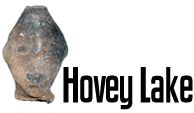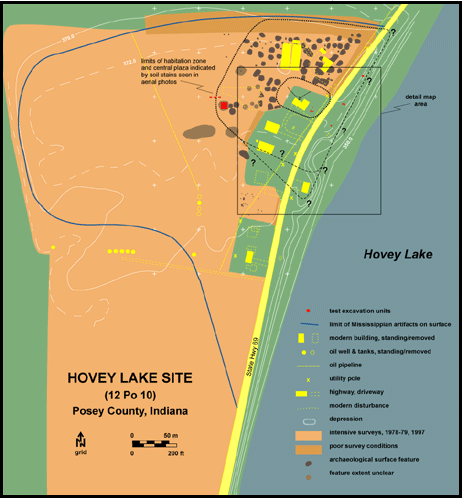 |
|
CURRENT
RESEARCH |
Learn more about Indiana Archaeology Month at Hovey Lake HERE! |
| Research at the Hovey Lake site in 2003-2005 is supported by: a grant from the Federal Highway Administration (FHWA) under the Transportation Enhancement Program,
Indiana University, and private contributions. The Indiana Department of Transportation
(INDOT) administers the TE grant. Also contributing to the research project are: Indiana Geological Survey,
Indiana University - Bloomington Department of Anthropology, the Indiana State Museum, University of Southern Indiana, University of Evansville, Indiana State University, and community groups and volunteers. |
Last Updated 9.6.2004 |
The Site
The Hovey Lake site is located on the west bank of Hovey Lake, a backwater lake near the Ohio River, which is known today for its waterfowl, fish, and cypress trees. The site extends over almost 30 acres part of which is on state property managed by the Indiana Department of Natural Resources, Division of Fish & Wildlife. Beginning in 1975, archaeologists have carried out surveys over much of the surface of the site and conducted small-scale excavations in eleven areas of this large village.Cheryl Ann Munson, archaeologist in the Department of Anthropology, Indiana University-Bloomington, has directed this research.

View of Hovey Lake with Cypress trees growing on the bank and in the water.
For more information on the Hovey Lake Fish and WIldlife Area go HERE!

The prehistoric Mississippian people who lived in the Hovey Lake village were part of a Mississippian culture that archaeologists call Caborn-Welborn. Archaeologists now think that this population and and the Caborn-Welborn population developed out of the decline of the society centered at the Angel site (now Angel Mounds State Historic Site) near Evansville, Indiana. Other elements of the Caborn-Welborn culture reflect trade or other interactions with late prehistoric populations to the north and northwest (Oneota) and south and southeast (central Mississippi River Valley and western and eastern Tennessee).
The Caborn-Welborn people located their communities near the Mouth of the Wabash
River, along a 40 mile stretch of the Ohio River. They lived in large and small
villages, hamlets, and farmsteads from about A.D. 1400 to 1700. The Hovey Lake
archaeological site is one of their large villages.

Map of the Hovey Lake site depicting work conducted
through 2002.
Click on the map for a much larger version (opens in a new window)


